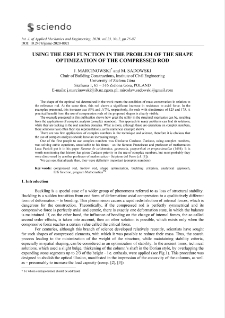Zielonogórska Biblioteka Cyfrowa udostępnia 65 391 obiektów cyfrowych
Obiekt
Tytuł: Using the ERFI function in the problem of the shape optimization of the compressed rod
Współtwórca:
Tytuł publikacji grupowej:
Abstract:
The shape of the optimal rod determined in the work meets the condition of mass conservation in relation to the reference rod. At the same time, this rod shows a significant increase in resistance to axial force. In the examples presented, this increase was 80% and 117%, respectively, for rods with slenderness of 125 and 175. A practical benefit from the use of compression rods of the proposed shapes is clearly visible. ; The example presented in this publication shows how great the utility in the structural mechanics can be, resulting from the applications of complex analysis (complex numbers). This approach to many problems can find its solutions, while they are lacking in the real numbers domains. What is more, although these are operations on complex numbers, these solutions have often their real representations, as the numerical example shows. ; There are too few applications of complex numbers in the technique and science, therefore it is obvious that the use of complex analysis should have an increasing range. One of the first people to use complex numbers was Girolamo Cardano. Cardano, using complex numbers, was solving cubic equations, unsolvable to his times - as the famous Franciscan and professor of mathematics Luca Pacioli put it in his paper "Summa de arithmetica, geometria, proportioni et proportionalita" (1494). ; It is worth mentioning that history has given Cardano priority in the use of complex numbers, but most probably they were discovered by another professor of mathematics - Scipione del Ferro. We can see, that already then, they were definitely important (complex numbers).
Wydawca:
Zielona Góra: Uniwersytet Zielonogórski
Format:
Identyfikator zasobu:
DOI:
Strony:
Źródło:
IJAME, volume 25, number 2 (2020)
Jezyk:
Licencja:
Licencja CC BY-NC-ND 4.0:
Prawa do dysponowania publikacją:
Biblioteka Uniwersytetu Zielonogórskiego
Kolekcje, do których przypisany jest obiekt:
- Zielonogórska Biblioteka Cyfrowa > Repozytorium > Jednostki organizacyjne > Wydział Mechaniczny
- Zielonogórska Biblioteka Cyfrowa > Repozytorium > Typy utworów > Artykuły
- Zielonogórska Biblioteka Cyfrowa > Repozytorium > Czasopisma naukowe i serie wydawnicze UZ > International Journal of Applied Mechanics and Engineering (IJAME) > International Journal of Applied Mechanics and Engineering (IJAME) (2020)
Data ostatniej modyfikacji:
6 lip 2023
Data dodania obiektu:
23 lut 2023
Liczba wyświetleń treści obiektu:
200
Wszystkie dostępne wersje tego obiektu:
https://zbc.uz.zgora.pl/publication/78096
Wyświetl opis w formacie RDF:
Wyświetl opis w formacie OAI-PMH:
| Nazwa wydania | Data |
|---|---|
| Using the ERFI function in the problem of the shape optimization of the compressed rod | 6 lip 2023 |
Obiekty Podobne
Marcinowski, Jakub Sadowski, Mirosław Kuczyński, Tadeusz - red.
Marcinowski, Jakub Kuczyński, Tadeusz - red.
Marcinowski, Jakub Świtka, Romuald - red.
Marcinowski, Jakub Kuczyński, Tadeusz - red.
Marcinowski, Jakub
Błażejewski, Paweł Marcinowski, Jakub Kuczyński, Tadeusz - red.

